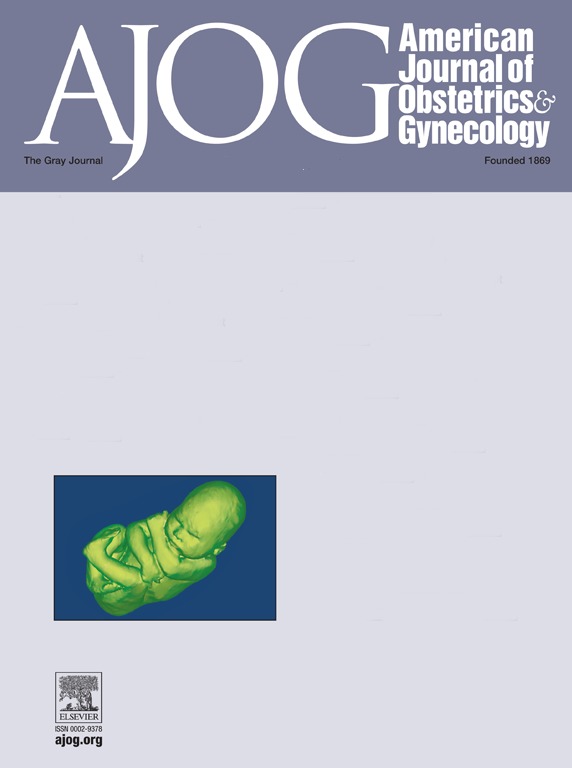Subsequent risk for preterm birth following second trimester medical termination of pregnancy.
IF 8.7
1区 医学
Q1 OBSTETRICS & GYNECOLOGY
引用次数: 0
Abstract
BACKGROUND Medical termination of pregnancy (using mifepristone and misoprostol) is a commonly performed health intervention. High quality cohort studies are warranted to investigate the association of second-trimester medical termination of pregnancy and subsequent pregnancy outcomes. OBJECTIVE This study aims to assess the risk of subsequent spontaneous preterm birth following second trimester medical termination of pregnancy. STUDY DESIGN We performed a cohort study in the Amsterdam University Medical Centre, location AMC. We included all individuals who underwent a second trimester medical termination of pregnancy between 2008-2023 using mifepristone and/or misoprostol and had a known subsequent pregnancy up to 2024. Exclusion criteria were other methods of termination (e.g. cesarean section, hysterectomy, curettage or foley catheter) and indication for mTOP due to intra-uterine fetal demise or previable prelabor rupture of membranes. The primary outcome was spontaneous preterm birth < 37 weeks in the subsequent pregnancy. Secondary outcomes included subsequent miscarriage < 16 weeks, repeated termination, and rates of total, spontaneous and iatrogenic preterm birth < 37, < 32 and < 28 week. Subgroup analyses were performed on the interpregnancy interval, gestational age at medical termination of pregnancy and postpartum surgical interventions using logistic regression estimating odds ratios (OR) and 95% confidence intervals, with adjustment for confounders. Subsequent singleton and multiple pregnancies were assessed separately. RESULTS Out of the 1,438 eligible cases, 1,033 were known to have a subsequent pregnancy of which 986 outcomes were available (singletons n=962, multiples n=24). In subsequent singleton pregnancies exceeding 16 weeks, spontaneous preterm birth < 37 weeks occurred in 39/831 cases (4.7%). In multiples, spontaneous preterm birth < 37 weeks occurred in 4/24 cases (16.7%). In subsequent singletons, rates of spontaneous preterm birth < 37 weeks were higher following an IPI < 3 months compared to 12-24 months (6.8% vs 3.2% aOR 2.2 95% CI 0.69-7.4, p-value 0.2), and higher for a GA >20 weeks at mTOP compared to < 12+0 - 15+6 weeks (5.9% vs 2.6% aOR 2.2 95% CI 0.92 - 5.4, p-value 0.07), though both not statistically significant. However, when gestational age at mTOP was included as a continues variable (in weeks) in a linear regression model, a significant positive association with subsequent spontaneous preterm birth was found (B=0.56, R2=0.31, p=0.04). CONCLUSION Second-trimester medical termination of pregnancy can be considered safe with regards to subsequent spontaneous preterm birth risk. As recommended following preterm and term birth, patient counseling should include the importance of allowing time for cervical remodeling to mitigate preterm birth risks, especially for those with a medical termination of pregnancy at higher gestational ages.妊娠中期医学终止妊娠后早产的后续风险。
医学终止妊娠(使用米非司酮和米索前列醇)是一种常用的健康干预措施。有必要进行高质量的队列研究,以调查妊娠中期医学终止妊娠与随后妊娠结局的关系。目的本研究旨在评估妊娠中期医学终止妊娠后自发性早产的风险。研究设计:我们在位于AMC的阿姆斯特丹大学医学中心进行了一项队列研究。我们纳入了所有在2008-2023年期间使用米非司酮和/或米索前列醇进行妊娠中期医学终止妊娠且在2024年之前已知妊娠的个体。排除标准为其他终止方式(如剖宫产、子宫切除术、刮宫或导尿管)以及因宫内胎儿死亡或产前胎膜破裂导致的mTOP指征。主要结局为自发性早产< 37周的后续妊娠。次要结局包括后续流产< 16周,重复终止妊娠,总早产率、自发性早产率和医源性早产率< 37周、< 32周和< 28周。采用logistic回归估计优势比(OR)和95%置信区间,并对混杂因素进行调整,对解释间隔、药物终止妊娠时的胎龄和产后手术干预进行亚组分析。随后的单胎和多胎妊娠分别进行评估。结果在1438例符合条件的病例中,已知1033例随后怀孕,其中986例可获得结果(单胎n=962,多胎n=24)。在随后超过16周的单胎妊娠中,自发性早产< 37周的发生率为39/831(4.7%)。在多胎中,自发性早产< 37周占4/24(16.7%)。在随后的单胎中,IPI < 3个月与12-24个月相比,自发性早产率< 37周更高(6.8% vs 3.2% aOR 2.2 95% CI 0.69-7.4, p值0.2),而GA bb0 20周与mTOP < 12+0 - 15+6周相比,自发性早产率更高(5.9% vs 2.6% aOR 2.2 95% CI 0.92 - 5.4, p值0.07),尽管两者均无统计学意义。然而,当在线性回归模型中将mTOP胎龄作为一个连续变量(以周为单位)纳入时,发现与随后的自发性早产有显著的正相关(B=0.56, R2=0.31, p=0.04)。结论妊娠中期药物终止妊娠可避免随后发生自发性早产的风险。根据建议,在早产和足月分娩后,患者咨询应包括允许时间进行颈椎重塑以减轻早产风险的重要性,特别是对于那些在较高胎龄时医学终止妊娠的患者。
本文章由计算机程序翻译,如有差异,请以英文原文为准。
求助全文
约1分钟内获得全文
求助全文
来源期刊
CiteScore
15.90
自引率
7.10%
发文量
2237
审稿时长
47 days
期刊介绍:
The American Journal of Obstetrics and Gynecology, known as "The Gray Journal," covers the entire spectrum of Obstetrics and Gynecology. It aims to publish original research (clinical and translational), reviews, opinions, video clips, podcasts, and interviews that contribute to understanding health and disease and have the potential to impact the practice of women's healthcare.
Focus Areas:
Diagnosis, Treatment, Prediction, and Prevention: The journal focuses on research related to the diagnosis, treatment, prediction, and prevention of obstetrical and gynecological disorders.
Biology of Reproduction: AJOG publishes work on the biology of reproduction, including studies on reproductive physiology and mechanisms of obstetrical and gynecological diseases.
Content Types:
Original Research: Clinical and translational research articles.
Reviews: Comprehensive reviews providing insights into various aspects of obstetrics and gynecology.
Opinions: Perspectives and opinions on important topics in the field.
Multimedia Content: Video clips, podcasts, and interviews.
Peer Review Process:
All submissions undergo a rigorous peer review process to ensure quality and relevance to the field of obstetrics and gynecology.

 求助内容:
求助内容: 应助结果提醒方式:
应助结果提醒方式:


